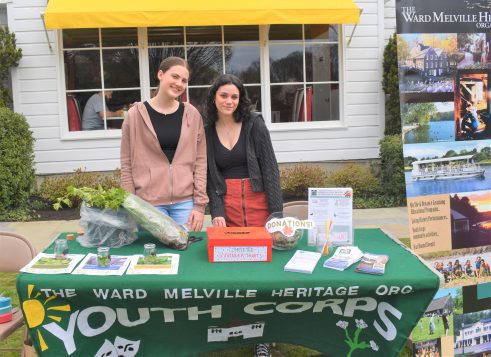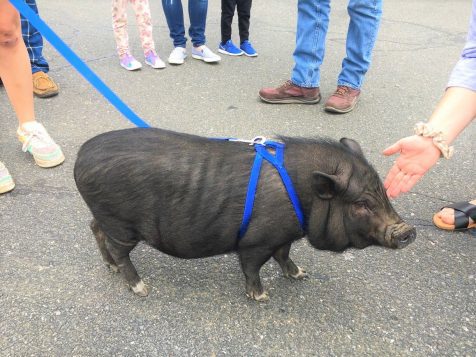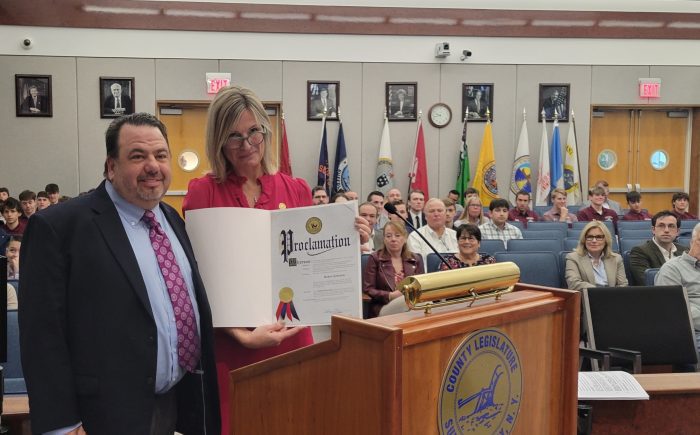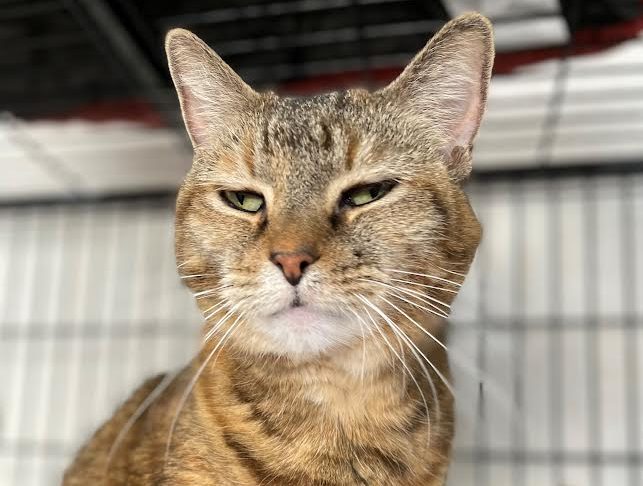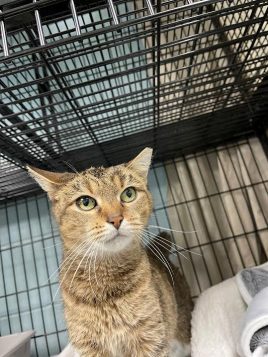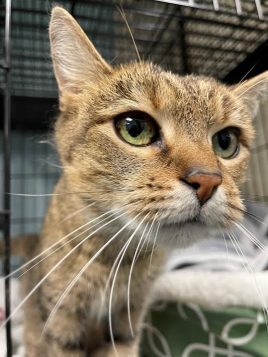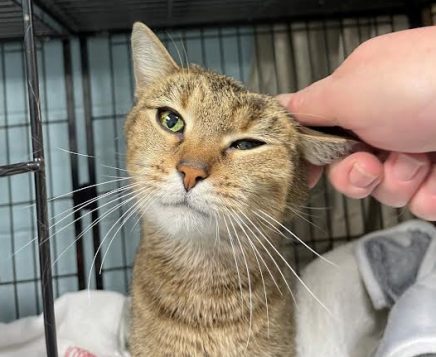Stony Brook Village’s Spring Appreciation Day on April 23 was a huge success, drawing thousands to the Stony Brook Village Center for live music by Burke and Brent, a car show, vintage vehicles by the Antique Automobile Club of America, a petting zoo courtesy of Racing Horse Farms, and scavenger hunt by the Ward Melville Heritage Organization (WMHO)’s Youth Corps and tours of the Stony Brook Grist Mill.
Shelter Pet of the Week: Mia
MEET MIA!
This week’s featured shelter pet is Mia, a 3-year-old pitbull/mastiff/lab mix who has sadly been at the Smithtown Animal Shelter for 2 years.
A volunteer favorite, Mia is a goofy dog who loves to play and throw toys around to make you laugh. She also enjoys car rides and snuggles!
Mia is very nervous about new people. She will need a home that can properly introduce her to a new environment in a way that makes her feel safe. She would do best as the only pet in an adult only home.
If you would like to meet Mia, please call ahead to schedule an hour to properly interact with her in a domestic setting.
The Smithtown Animal & Adoption Shelter is located at 410 Middle Country Road, Smithtown. Visitor hours are currently Monday to Saturday from 10 a.m. to 3 p.m. (Sundays and Wednesday evenings by appointment only). For more information, call 631-360-7575 or visit www.smithtownanimalshelter.com.
Ask the Vet: Tips to avoid a dog bite
By Matthew Kearns, DVM

You can’t log onto the internet without finding some sort of clickbait story about a dog attack. It is estimated that approximately 370,000 people are bitten by dogs every year. Although I believe that aggression is never appropriate and should not be condoned, recognizing aggression and problem situations is the key to avoiding bites. Here is a list of the different types of dog aggression:
Territorial Aggression — the need to protect its territory is hardwired in dogs long before they were domesticated. If a dog senses (or perceives) that someone or something has violated its territory, it will feel the need to defend itself. This could refer to the dog that is barking and snarling at the fence. Dogs do not differentiate property lines and will soon consider any portion of the block their territory.
Fear Related Aggression — this is where a normally friendly dog becomes so fearful that any type of interaction is taken as a threat and they respond with aggression to “defend themselves.” This very commonly happens at the veterinarian’s office.
Food Aggression — growling and snapping if a person comes near the dog when they have a treat, near the food bowl, etc, is inappropriate and intervention is needed.

Dominance Aggression — this type of aggression can be directed against other pets in the household or family members and will manifest itself when the dominant dog is challenged.
Here are a few tips on avoiding potentially dangerous situations:
■ Always approach a dog you have never met before with your palm up below their muzzle. This is an act of deference or neutrality, whereas approaching a dog with your palm down and above the head (as if to pet the dog) is an act of dominance or aggression.
Also, if a dog is growling, barking, or snarling but still is wagging its tail; believe the growl/bark/snarl. I have seen many a dog attack another dog (or person) while still wagging its tail.
■ Beware of dogs roaming the neighborhood. Although most have just escaped the yard and are no threat, approach with caution and have an escape route for yourself.
■ If a dog is growling and hiding in a corner do not try to engage them, but rather ignore the behavior and let them come to you.
■ If you notice any signs of aggression as a puppy bring them to the attention of your veterinarian and consider one on one training with a behaviorist.
I hope this helps to recognize aggressive behavior to either avoid dangerous situations or intervene early on so that we can all enjoy our barking, furry family members safely.
Dr. Kearns practices veterinary medicine from his Port Jefferson office and is pictured with his son Matthew and his dog Jasmine.
Founder of Bald Eagles of Centerport Facebook group honored
At the April 12th general meeting of the Suffolk County Legislature, Legislator Stephanie Bontempi (Centerport) formally recognized Robert Schwartz, founder of the Bald Eagles of Centerport Facebook group. In addition to Bontempi sharing a little bit about Mr. Schwartz’s contributions to the community, he was presented with a proclamation to commemorate such.
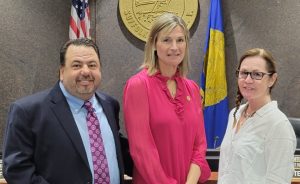
Schwartz’s group has an enormous following and has become an important advocacy platform for the protection of the local bald eagles and the environment in general. The group’s presence on social media also provides an opportunity for bald eagle admirers to share their photos and stories associated with their unique encounters with the national bird.
“In Huntington, when one thinks of its bald eagles, Mr. Schwartz’s group will likely come to mind. The ever-growing following of the Bald Eagles of Centerport is proof of its ability to communicate how special these birds are,” said Bontempi. On top of his interest and advocacy work associated with the bald eagles, Schwartz is also a thriving beekeeper. Whenever there is an opportunity to share his knowledge in these two arenas, he does so with great enthusiasm and has likely inspired many individuals of all ages.
“Whenever Mr. Schwartz talks about the bald eagles or his beekeeping activities, you cannot help but listen intently as his passion is contagious. As a former teacher, it is fantastic to see someone with such a thirst for knowledge and the ability to motivate others to broaden their horizons in constructive and unique ways,” added Bontempi.
Shelter Pet of the Week: Sunny Girl
MEET SUNNY GIRL!
This week’s featured shelter pet is Sunny Girl, a 9 to 10-year- old spayed domestic short hair waiting at the Smithtown Animal Shelter for her furever home.
Sunny Girl has a disposition that matches her name. She is a loving senior cat that will curl up on your lap and reciprocate all of the love that you show her. Sunny came from a home with lots of other cats and loves most of them too. She does have an overactive thyroid and will need a home that can administer twice daily medications and take her to the vet twice a year to check her thyroid levels.
If you would like to meet Sunny Girl, please call ahead to schedule an hour to properly interact with her in a domestic setting.
The Smithtown Animal & Adoption Shelter is located at 410 Middle Country Road, Smithtown. Visitor hours are currently Monday to Saturday from 10 a.m. to 3 p.m. (Sundays and Wednesday evenings by appointment only). For more information, call 631-360-7575 or visit www.smithtownanimalshelter.com
Paw Prints: Meet shelter pets Angel, Dewey, Lesley, Mercedes, Richie and Dexter!
 Welcome to the fourth edition of Paw Prints, a monthly column for animal lovers dedicated to helping shelter pets find their furever home!
Welcome to the fourth edition of Paw Prints, a monthly column for animal lovers dedicated to helping shelter pets find their furever home!
Meet Angel
This is Angel, a female pitbull up for adoption at the Smithtown Animal Shelter. On April 14, Angel will hit her 4 year anniversary as a homeless dog. This 8-year-old beauty loves every person she meets. She is strong in will and body and will need a leader that can be strict with her and setting boundaries. Angel loves food, walks, car rides, kiddie pool and any toy she can shred to pieces. She cannot be placed with other animals. This girl has a huge heart and wants her happily ever after! Will you be her hero? For more information, call 631-360-7575.

Meet Dewey
Dewey is ready to hop into your Easter baskets this holiday! This beautiful boy is a 5-month-old Beagle/Chihuahua mix from Georgia. He’s a little on the shy side, but he’s a puppy, so once he gets comfortable in a cozy home he will make a lovely companion. His brothers Louie and Huey were already adopted from Kent Animal Shelter in Calverton and now its Dewey’s turn. Come by and meet him today! Call 631-724-5731, ext. 1.

Meet Lesley
Lesley was found as a stray in Queens but is now safe at Little Shelter Adoption Center in Huntington. Lesley loves to play and run and watches everything since he needs to know what you’re up to! Call 631-368-8770.
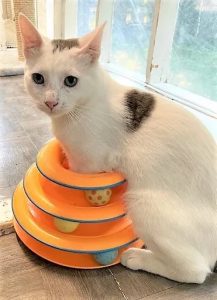
Meet Mercedes
This sweet girl is looking for love. She arrived at the Brookhaven Animal Shelter after being taken out of a bad situation and is now looking for her soul-mate. At two and a half years young, Mercedes is playful and energetic yet gentle and affectionate. She loves to play with you, enjoys tennis balls, squeaky toys and she will bring a smile to your face. Mercedes will need a patient person who is willing to give her the direction and guidance she was not given as a puppy. She will do best as the only pet in an adult household. Call 631-451-6950.

Meet Richie – Update: Richie has been adopted!!!
Richie is all ears about finding a new home for Easter! A 2-year-old Terrier mix with a super sweet disposition, Richie is up for adoption at Kent Animal Shelter in Calverton. An active guy, he would love to have a big yard to run in, and maybe some kids to play with. He loves people, and enjoys going on walks on warm spring days. Come meet Richie today! Call 631-724-5731, ext. 1.

Meet Dexter
Dexter is a goofy young active boy looking for his perfect home! He was brought to the Brookhaven Animal Shelter by a Good Samaritan after being found as a stray with his leash still attached. Sadly, no one came looking for him. Dexter is your typical cattle dog, he is extremely intelligent with a high drive, and will need continuous physical AND mental exercise. He is housebroken, walks well on leash and knows many commands. He is about 1 to 2 years young, and is 58 pounds. He is not a fan of cats and will require a meet and greet with a dog. Call 631-451-6950.

— Compiled by Heidi Sutton
Photo of the Week
ALL EARS
Visitors to Stony Brook Village this week will be treated to a beautiful lawn display on Christian Avenue. The approximately 15-foot cascading scene with large Easter eggs, bunnies and chicks is an annual event that brings a smile to all who drive by. Photo by Heidi Sutton/TBR News Media
Send your Photo of the Week to [email protected]
Pet food drive for Long Island Cares underway
Town of Brookhaven Supervisor Ed Romaine has announced that the town will take part in Long Island Cares’ annual Legislative Pet Food Drive Challenge through April 22. Now in its 11th year, the drive is focused on collecting and providing food for the family members most vulnerable to hunger — our pets. Drop off locations include:
◉Brookhaven Town Hall, 1 Independence Hill, Farmingville
◉Brookhaven Animal Shelter, 300 Horseblock Road, Brookhaven
◉Coram Fire Department, 303 Middle Country Road, Coram
◉College 101 Resource Center, 290 Main Street, East Setauket
◉Brookhaven Town Highway Department, 1140 Old Town Road, Coram
◉Brookhaven Town Parks and Recreation Administration, 286 Hawkins Road, Centereach
Suggested donation items include canned dog and cat food, five to ten-pound bags of dry food and treats.
“Many residents are struggling to make ends meet, and this means they are also struggling to find the means to feed their pets,” said Supervisor Romaine. “I look forward to seeing how much food is collected and I want to thank Long Island Cares for all the work they do to feed those in need in Brookhaven Town and across Long Island.”
Vanderbilt Museum hosts Ecology and Climate Change lecture April 14
As part of its Ecology and Climate Change lecture series, the Suffolk County Vanderbilt Museum, 180 Little Neck Road, Centerport will welcome Stony Brook University’s Heather Lynch for a presentation titled Mapping Penguins with Satellites, Drones and Other Technologies in the Charles and Helen Reichert Planetarium on April 14 at 7 p.m.
In Mapping Penguins, with Satellites, Drones, and Other Technologies, Professor Lynch will share insights from her innovative research into the population dynamics of penguins on the Antarctic Peninsula. To better understand rises and falls in this population due to climate change, tourism, and fishing, Lynch marries traditional field work with a range of technologically sophisticated methods including satellite remote sensing, drone imaging, and advanced computational models.
“Penguin populations have been changing rapidly over the last 40 years,” says Lynch. “But understanding why those changes have occurred and what we might expect for the future is a surprisingly difficult challenge. [In this lecture,] I’ll discuss the threats facing Antarctic penguins and how scientists are bringing together new technology, artificial intelligence, and advanced predictive modeling to help guide policymakers in their work to protect one of the world’s last remaining wildernesses.”
Dr. Heather J. Lynch is the Institute for Advanced Computational Sciences Endowed Chair for Ecology & Evolution at Stony Brook University. She earned a B.A. in Physics from Princeton University, an M.A. in Physics from Harvard University, and a Ph.D. in Organismal and Evolutionary Biology from Harvard. She is also a National Geographic Explorer and past winner of the Blavatnik Award for Young Scientists.
Join Lynch as she shares her insight and research. $6 per person, members free. To register, visit www.vanderbiltmuseum.org.
Shelter Pet of the Week: Bella
This week’s featured shelter pet is Bella, a 5 to 6-year-old female domestic shorthair up for adoption at the Smithtown Animal Shelter.
Sweet Bella has a sad story. She was abandoned in a duct-taped garbage pail in a parking lot. To make matters worse, she was suffering from pyometra (an infection of the uterus). Terrified and distrusting, she took some time to warm up to us, but when she did the snuggles became very real. She is shy at first, so she would do best in a quiet home.
If you would like to meet Bella, please call ahead to schedule an hour to properly interact with her in a domestic setting.
The Smithtown Animal & Adoption Shelter is located at 410 Middle Country Road, Smithtown. Visitor hours are currently Monday to Saturday from 10 a.m. to 3 p.m. (Sundays and Wednesday evenings by appointment only). For more information, call 631-360-7575 or visit www.smithtownanimalshelter.com.




